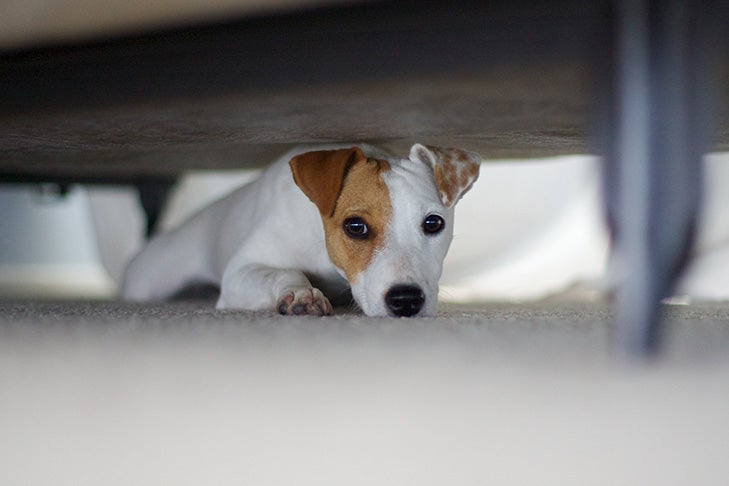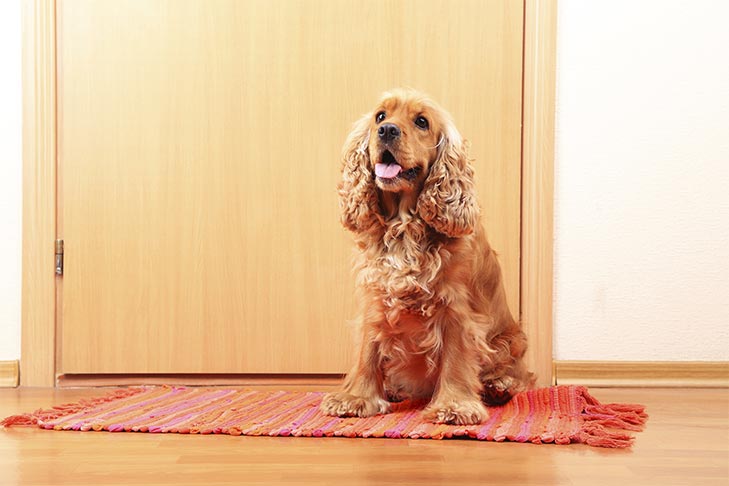A few weeks ago, my dog began barking at 4 a.m. At first, I assumed she was barking at the raccoons in our backyard trees, but then I noticed a horrible roaring sound. Looking out the windows, I saw flames licking at my neighbor’s roof.
Immediately, I put our fire drill plan into place. I put my cat in a travel carrier, leashed my dog, and grabbed emergency materials while calling 911, prepared to leave if needed. Thankfully, my neighbors and their dog were safe, and the fire department arrived quickly, putting out the flames before they spread. But having a plan in place can be lifesaving for your dog in the event of a house fire.
Preparing Your Dog in Case of a House Fire
It’s always a good idea to make sure your home is up to date in terms of house fire prevention. Make sure you have working smoke detectors on every level of the house or home, and replace batteries twice annually unless you’ve opted for 10-year lithium batteries. Test your smoke detectors often to make sure they’re still working in the event of an emergency. You should replace your smoke detectors every 10 years or follow the instructions accompanying the device. Having a fire extinguisher in your kitchen is also a good idea. Follow other general fire safety tips at home.
There are things you can do to prepare your dog for a possible house fire. Put emergency alert stickers on your doors or in your windows to let firefighters know that you have pets inside needing to be rescued. On the sticker, be sure to write down the types and numbers of pets you have, as well as your vet’s phone number. This is especially important in case a fire breaks out when you’re not home.

Your dog might run to find you if there is a fire, just like mine did. If your dog is stressed, they may try to hide, which can be dangerous in a situation where you need to exit quickly. Know where your dog sleeps in the house, and keep in mind areas where your dog might hide or sleep when they are upset or stressed in the event of a fire. Have your dog microchipped and update the information on record with the microchip company as necessary. This way, if they do get loose, they can be scanned and returned to you when found. Make sure your dog is always wearing a collar with identification tags that have updated information. This can help reunite you with your dog if you get separated.
Building a Pet Disaster Kit Your Dog in Case of Fire
In the event of a house fire, you’ll want to leave as quickly and safely as you can. As soon as you notice early signs of a fire, like smelling smoke or your alarms going off, you’ll want to put your emergency plan into action. It’s helpful to keep a small go-bag in an easily accessible place with emergency items and documents for your dog. Keep a leash for your dog next to each door you might need to evacuate through, along with a pet carrier for your dog or other pets.
What to Put in Your Pet Disaster Kit
- Two weeks’ worth of dog food
- Your dog’s medications
- Water in waterproof containers
- Spill-proof food and water bowls
- A dog travel carrier with dog bedding and blankets or towels for your dog
- A can opener for dog food
- A dog leash, dog harness, and dog collar with your dog’s identification tags
- Feeding and medication instructions
- One month’s supply of flea and tick preventatives or heartworm preventatives
- Dog first-aid kit
- Poop bags and any dog clean-up and potty supplies
- Items to help keep your pet calm
- Dog toys to keep them busy

Important Documents You Should Include in Your Pet Disaster Kit
- Contact information for you and your vet
- Prescriptions for any medications your dog is on
- Recent photo of your dog
- A written description of your dog, as well as a summary of their medical conditions
- Microchip information (like the microchip number and contact information for the microchip company)
- Information about any health, behavioral, or medication-based issues your pet may have
- Vaccination certificates (including their rabies certificate)
- Copies of vet records
- Recent heartworm test results
- Your dog’s identification and registration information (like AKC registration information and your proof of ownership)
Ahead of time, it’s a good idea to digitize these documents and store them in your email or in the cloud. The images could be used for signs and postings if your dog gets lost. This also makes them more easily accessible for you in case you can’t access the original copies.
Practice Fire Drills With Your Dog
Remember fire drills in school? Doing these at home is actually a great way to help you and your dog get prepared for an emergency. It will prepare you, but also get your dog more familiar with the cues that you’d use in this scenario. Hopefully, if they’re used to the procedure, they’ll know what to do, and you can feel more confident that you can get out safely together.
Know how to get out the door and away from your house quickly. Time how long it takes for you to find your dog in the house, put on their leash, grab any emergency supplies or go-bag, and get out of your home. Arrange a place to meet with your other family members once you evacuate, and make sure everyone knows how to get your pets out safely as well as themselves.

If you live in an apartment building, make sure your dog is comfortable going down fire exits or stairs ahead of time. During your drills, exit the building by the stairs. In the event of an actual fire, you won’t be able to use the elevator.
Dog Training Tips for House Fire Evacuation Procedures
It’s also useful to practice your dog’s basic obedience skills, not only for this situation. If your dog understands cues and you work well together, you will also be able to handle unexpected situations more easily. You’ll want to regularly practice your dog’s door manners and be sure your dog knows how to come when called. Teaching a strong recall and practicing regularly will help you find your dog quickly in the house in the event of an emergency, while making sure they don’t dart out the door will stop the dog from getting lost.

Practice calling your dog to you from different places in the house and at different times of the day and night, praising and rewarding when they come to you. Similarly, practice putting your dog’s leash on quickly when you evacuate. If you practice putting the leash on and exiting rapidly, your dog will be familiar with this action and it will help them stay calm if you have to do this in a real emergency.
When You Evacuate Your Dog From a House Fire
If you ever do have a fire in your house, the most important thing is to get yourself your family and your pets out. If it’s possible for you to do so, attach your dog’s leash before evacuating your home, or if your dog is small, put them into a travel carrier. Keep them at your side at all times, and try to stay as calm as you can. As stressful as a fire is, your dog senses your emotions, and will become more worried if they pick up that you are.
When firefighters arrive, the area will be filled with strangers, loud noises, bright lights, and many smells, which can be stressful for your dog. While you can never fully prepare for an emergency, socializing your dog in crowds and having them be familiar with loud noises can help them feel less overwhelmed.

Once you are a safe distance away from the flames, keep your dog leashed, close to you, and away from firefighters. Follow all instructions from firefighters. The most important thing is that you, your pets, and your family are safe.







